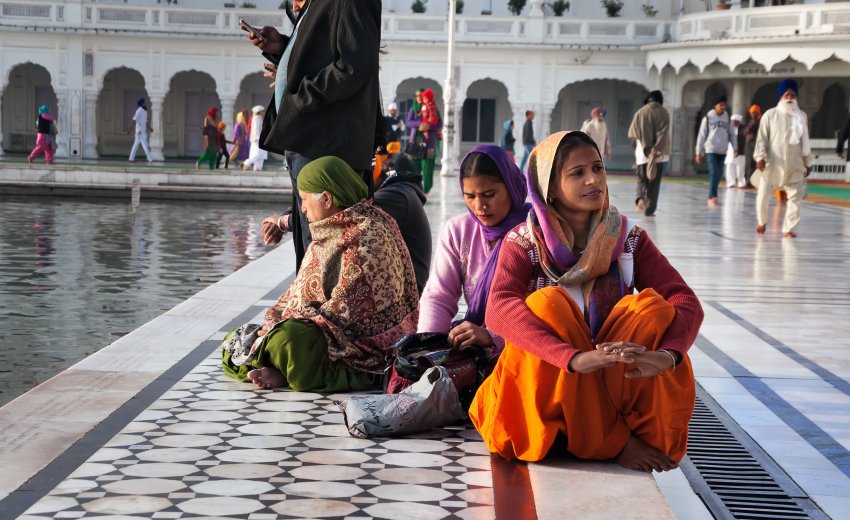We live in a time of unprecedented innovation. Aside from the colour of the sky (mostly) and the fact that people still breathe, a good deal of what we have taken for granted for millennia is now being called into question. We are faster and potentially deadlier. We live longer, communicate over greater distances, and generally make our mark all over our planet (and beyond) as never before.
Some months ago, I wrote an article published here on Sikhnet that chronicled the course of some well-known Sikh women today. In my research, I found that many of these bright stars remained unmarried, presumably to focus better on their life’s calling. A surprising number chose to marry outside the Sikh community with its duplicitous claims of gender equality. Not a nice finding for a modern religion that claims not to discriminate against women.
In the article, I particularly decried the prohibition against women’s equal participation in Gurdwara, especially their being banned from performing keertan in Sri Harimandir Sahib. I concluded by saying:
What awards and respect conservative Singh Sahibs and Granthis accord them may be seen as awards and respect for us all. And whatever is denied the women and girls of this Panth, in truth, is denied each one of us for our destinies are inseparably intertwined, mother and daughter, father and son, for together we are the Guru Panth.
This previous article was also submitted for publication, but not accepted, by a popular Sikh magazine in India. In this way, the foot dragging and hypocrisy of conservatives continues in the face of continued pressure to allow women equal opportunity. Just the other day, a very senior official in Amritsar was heard to say they “have no opinion” on the ongoing struggle for women’s rights in Sri Harimandir Sahib.
It is apparent that many traditional clergy are simply ignorant of the world outside. Others seem set in their belief that “one cannot be modern and Sikh at the same time.” Their attitude appears to be the outcome of deeply ingrained prejudice together with a lack of education and imagination.
In this article, we will visit some of the sweeping developments changing gender relations today, particularly affecting women’s lives. We will also venture into the speculative future before us, then pause to reflect on where we are going and the impetus behind all these changes.
In my view, ignorance and denial will never get us to a better world. Feckless denial and woeful ignorance do not have any relationship with the true and glorious path of Bebe Nanaki and Mata Sahib Kaur Ji. In these days of tumultuous change, education, timely reflection and discussion are required.
Social pressures, fatal outcomes
Much has changed in the world in the past 300 years. In the old days – and still today where modernity has yet to make its influence felt – a mother had many children and risked dying in the course of one of her pregnancies, probably while giving birth. She underwent these risky pregnancies again and again, until she either passed the age of childbearing or lost her life through a breech birth or some other unfortunate complication.
One reason so many women died in childbirth was the lack of effective birth control. Another was that having many children was considered a guarantee of security in one's old age. In many cultures, it was thought that if one had ten or twelve children, at least one of them, usually the youngest daughter, would care for the parents during their final years. The third reason was the social pressure for women to obey their husband and generally to have large families. Sex and marriage were considered inseparable because it was understood that marriage would guarantee a home for any child born of a husband and wife.
Freedom to choose
Today we find ourselves in a different situation. With the advent of pensions and retirement homes, children are no longer expected to offer the level of care and material support that previous generations did to their aging parents. Moreover, birth control technology has evolved to the extent that conception can be pre-empted with considerable certainly.
Nowadays, a working woman may consider her long-term financial security better served by not having children at all. With a woman's rights being greater today, there is also less pressure to be a wife and mother. Moreover, with changing societal values in our post-industrial society, sex and childbirth outside the sanction of marriage are often possible with little or no social retribution.
Whatever the social and psychological ramifications of motherhood outside of marriage, and no doubt they vary according to individual circumstances, the happy reality is that a woman is no longer obliged to play reproductive Russian roulette. Rather than enduring multiple pregnancies at risk to her life and health, she can choose not to have children at all or to try for a healthy pregnancy and a healthy delivery supported by advances in modern gynecological practice.
Advances in reproductive care have given us more long-lived and healthy mothers than ever before. Newborns are also generally healthier. Few die in childbirth. At the same time, there are dramatic increases in the birth rate of autistic and Down's syndrome babies, with no real explanation other than that these too are an outcome of changing times.
Changing Society
While one might consider this to be the happiest of circumstances, where every pregnancy is a wanted pregnancy and every child a wanted child, as society has evolved, other factors have changed as well. Today's incidence of divorce and separation enables adult members of a relationship to be willing participants, but also creates a backdrop of potential instability and insecurity for raising children.
Parent-child relationships are not what they were before either. While children in traditional cultures used to learn the family trade from their parents, today they are educated outside the home. Spending a nearly a third of each day at school, children inevitably are exposed to ideas and behaviours unfamiliar in the home. This can be great or not so great, but the tendency is for many young people to develop separate interests and careers and to move away, often far from the family orbit.
Choice, convenience, diversity
While the present would have been unimaginable just a century ago, the future is likely to be similarly difficult to foresee, but judging from current developments, we might guess what lies perhaps twenty-five or fifty years ahead.
It would be surprising if the sustained push against the limitations of the human body were not to continue. Sub-themes of individual choice, convenience, and healthy outcomes might easily impact reproductive technologies, supported at first by exploratory research and then by demand for services. Pregnancy outside the body, mix and match chromosome selection, and hybridized human-android lifeforms are well within the scope of possibility.
Changing social norms are also likely to affect sexual practices. Given current trends, this is likely to include increasing acceptance of non-heterosexual lifestyles and pornography. Growing social isolation is also likely to impact overall sexual and reproductive practices.
Surrogates for future intimacy
Another development likely to change the nature of human relations is the creation of realistic androids. These may have many capabilities; to serve as caregivers for children and for the elderly, for example. In a culture increasingly driven by individual choice and profit, and uninhibited by traditional social constraints, they also are certain to be designed as satisfying sexual partners.
They will be programmed to engage in conversation, flirt, and make sounds of passion. A second generation may be programmed to shop and cook a great meal. As they will never argue or be disagreeable, they are certain to be in great demand. A third generation may well include the capacity to transmit life.
The value of life
Human life is an invaluable gift. Typically, we celebrate the arrival of a new child and congratulate especially the mother who carried that infant inside her, then laboured to deliver it.
Unfortunately, it is difficult for us to remain mindful of our fragile connection to the thread of life and our consummate relationship with womankind. Women themselves are apt to forget their special place in the helter-skelter of “making a living.” Without women – of all classes and aptitudes – life as we know it would not exist.
Our mothers are our first teachers, giving us our foundational understanding of life. Women’s propensity to develop social supports is at the core of our communities. As women are isolated by the constraints of poor urban planning, separated either into concrete silos called “condominiums” or by the distances imposed by suburban sprawl, social isolation rises for all of us.
Devaluation of life
It is not by chance that sex dolls are invariably female. It is for men alone they are designed and made. If most of the functions of a woman could be roboticized, these same men would gladly buy one or several to fill the open crevices of their empty lives.
Most depreciating of all is the conduct of modern war. Presidents and kings and prime ministers have at their command arsenals of weapons, once unimaginable, which some are far too eager to deploy. When piqued over issues of land or wealth or influence, they seem to say, “We will send our sons to kill your sons. And if our sons die, our mothers will give us more sons.” For them, life is cheap, weapons are expensive.
So-called “terrorists” – for all war is terrible and terrifying – are no less despicable. Like ghouls, they celebrate the deaths of shoppers, concert-goers, tourists, anyone really - while ironically expecting to enjoy life and love in endless paradise. Their cult of death is not so alien from our own however, being merely a low-tech reflection of what they see in our armed forces with their shiny legions of killer drones, bombers and nuclear submarines (2016 global expenditures worldwide: $1.7 trillion).
Humankind’s challenges
Humankind today faces unprecedented challenges. Perhaps womankind’s challenges are foremost. Indeed, some of these are dreadful to contemplate.
While we have observed the growing possibilities of personal autonomy afforded modern day women, we are also forced to recognize the fraying infrastructure of community and family. Moreover, thoughtless men everywhere, be they warmongers in white houses or schoolgirl killers of the Taliban or enforcers of antiquated moral codes in Amritsar, all do violence to the sacredness of life, and those among us - our mothers, sisters and daughters - who carry that life.
I do not believe a woman can be replaced by a machine, no matter the calibre and complexity of the technology. But we can degrade our relations with the women in our lives to the extent that we will be willing to accept a machine as a reasonable substitute. We may sing “Bhand jamiay…” all we want, but if we do not grant our womenfolk their rightful status as equal human beings, in my view we are hastening our descent into technological hell.
Sikh women are right to question the sincerity of their so-called “Panthic leaders” when they continue to deny them what is rightfully theirs. If archaic attitudes continue to predominate in Amritsar, we cannot blame bright, successful women for choosing celibacy or even marrying outside the Panth to achieve their happiness and fulfillment.
Seeking resolution
Perhaps the resolution of this crisis lies with the women of Amritsar. History tells us that when Guru Tegh Bahadur ji came from Bakala to pay his respects at Harimandir Sahib and the priests would not allow him to enter, the women of Amritsar then followed the Guru to beg his forgiveness for their audacity and to ask him to return. The ninth Guru told his followers that he had no complaint against the priests, but he pointedly declined their request to return. In appreciation of their devotion, however, the Guru blessed the ladies, saying “God’s love and devotion shall ever abide among you.”
God willing, the love and devotion in the blessed women of Amritsar can help us now.
References
- Greer, Germaine, Sex and Destiny: The Politics of Human Fertility, Toronto: Stoddart Publishing, 1984.
- Jacobsen, Knut A., and Kristina Myrvold, editors, Young Sikhs in a Global World: Negotiating Traditions, Identities and Authorities, Farnham, UK: Ashgate, 2015.
- Kamala, Elizabeth Nayar, The Sikh Diaspora in Vancouver: Three Generations Amid Tradition, Modernity, and Multiculturalism, Toronto: University of Toronto Press, 2004.
- Miles, Angela, editor, Women in a Globalizing World: Transforming Equality, Development, Diversity and Peace, Toronto: Inanna Publications and Education, 2013.
- Singh, Gurharpal, and Darshan Singh Tatla, Sikhs in Britain: The Making of a Community, London: Zed Books, 2006.
- Singh, Major Gurmukh, “Amritsar,” in The Encyclopedia of Sikhism, Volume I, ed. Harbans Singh, 108-116, Patiala: Punjabi University, 1995.
- Turkle, Sherry, Alone Together: Why We Expect More from Technology and Less from Each Other, New York: Basic Books, 2011.






